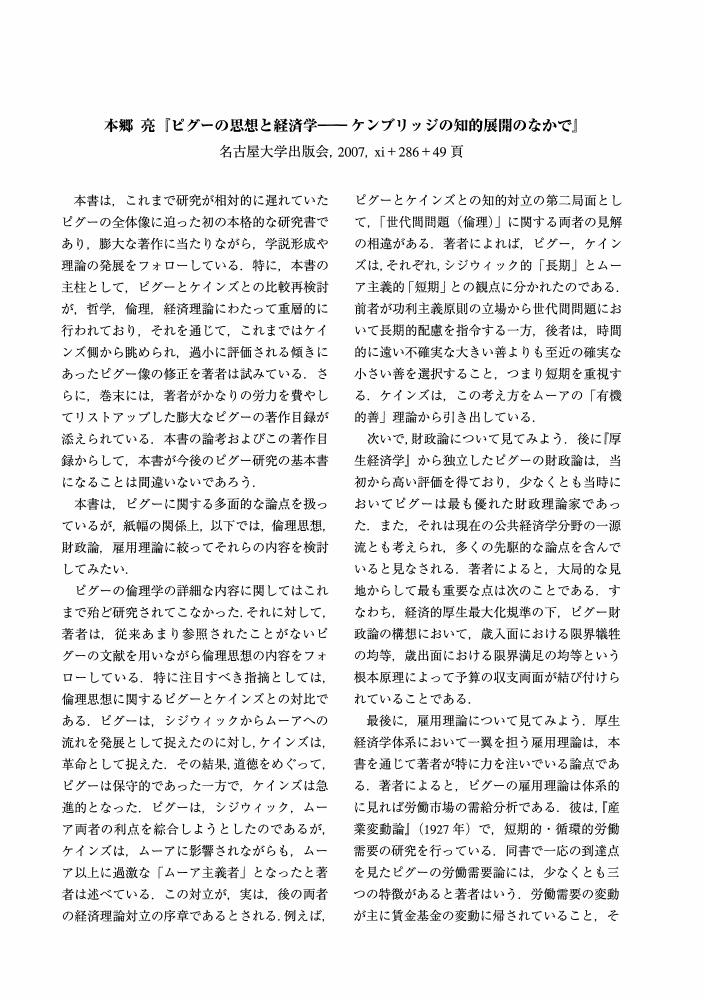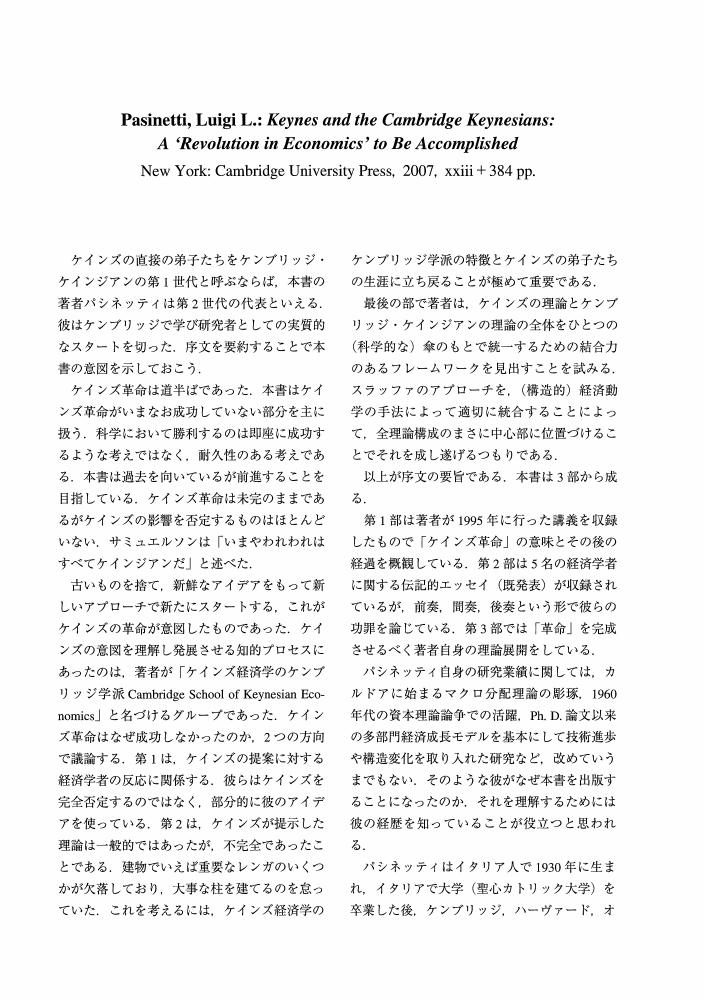- 著者
- 青木 裕子
- 出版者
- 経済学史学会
- 雑誌
- 経済学史研究 (ISSN:18803164)
- 巻号頁・発行日
- vol.51, no.1, pp.103-106, 2009 (Released:2019-06-22)
- 被引用文献数
- 1
- 著者
- 八木 紀一郎
- 出版者
- 経済学史学会
- 雑誌
- 経済学史研究 (ISSN:18803164)
- 巻号頁・発行日
- vol.51, no.1, pp.101-102, 2009 (Released:2019-06-22)
- 著者
- François Allisson
- 出版者
- The Japanease Society for the History of Economic Thought
- 雑誌
- 経済学史研究 (ISSN:18803164)
- 巻号頁・発行日
- vol.51, no.1, pp.19-35, 2009 (Released:2019-06-21)
- 参考文献数
- 20
- 被引用文献数
- 1 3
This paper evaluates the reception of Léon Walras’ ideas in Russia before 1920. Despite an unfavourable institutional context, Walras was read by Russian economists. On the one hand, Bortkiewicz and Winiarski, who lived outside Russia and had the opportunity to meet and correspond with Walras, were first class readers and very good ambassadors for Walras’ ideas, while on the other, the economists living in Russia were more selective in their readings. They restricted themselves to Walras’ Elements of Pure Economics, in particular, its theory of exchange, while ignoring its theory of production. We introduce a cultural argument to explain their selective reading. JEL classification numbers: B 13, B 19.
- 著者
- 大友 敏明
- 出版者
- 経済学史学会
- 雑誌
- 経済学史研究 (ISSN:18803164)
- 巻号頁・発行日
- vol.51, no.1, pp.36-59, 2009 (Released:2019-06-21)
- 参考文献数
- 40
- 著者
- 岡田 元浩
- 出版者
- 経済学史学会
- 雑誌
- 経済学史研究 (ISSN:18803164)
- 巻号頁・発行日
- vol.51, no.1, pp.93-95, 2009 (Released:2019-06-22)
- 著者
- 川俣 雅弘
- 出版者
- The Japanease Society for the History of Economic Thought
- 雑誌
- 経済学史研究 (ISSN:18803164)
- 巻号頁・発行日
- vol.51, no.1, pp.96-97, 2009 (Released:2019-06-22)
- 著者
- 石田 教子
- 出版者
- The Japanease Society for the History of Economic Thought
- 雑誌
- 経済学史研究 (ISSN:18803164)
- 巻号頁・発行日
- vol.51, no.1, pp.98-100, 2009 (Released:2019-06-22)
- 著者
- 河野 良太
- 出版者
- 経済学史学会
- 雑誌
- 経済学史研究 (ISSN:18803164)
- 巻号頁・発行日
- vol.50, no.2, pp.103-104, 2009-02-05 (Released:2010-08-05)
1 0 0 0 OA 西沢保『マーシャルと歴史学派の経済思想』岩波書店, 2007, xvi+646頁
- 著者
- 佐々木 憲介
- 出版者
- 経済学史学会
- 雑誌
- 経済学史研究 (ISSN:18803164)
- 巻号頁・発行日
- vol.50, no.2, pp.105-106, 2009-02-05 (Released:2010-08-05)
- 著者
- 山崎 聡
- 出版者
- 経済学史学会
- 雑誌
- 経済学史研究 (ISSN:18803164)
- 巻号頁・発行日
- vol.50, no.2, pp.109-110, 2009-02-05 (Released:2010-08-05)
- 著者
- 菊池 壮蔵
- 出版者
- 経済学史学会
- 雑誌
- 経済学史研究 (ISSN:18803164)
- 巻号頁・発行日
- vol.50, no.2, pp.111-112, 2009-02-05 (Released:2010-08-05)
1 0 0 0 OA Walras in Spain (1874-1936)
- 著者
- Jesús Astigarraga Juan Zabalza
- 出版者
- The Japanease Society for the History of Economic Thought
- 雑誌
- 経済学史研究 (ISSN:18803164)
- 巻号頁・発行日
- vol.51, no.1, pp.1-18, 2009 (Released:2019-06-21)
- 参考文献数
- 20
This article focuses on the fate of Walras and Walrasian ideas in Spain, which should be contextualised within the coming of marginalism to Spain. Traditionally, it has been accepted that marginalism was almost forgotten by Spanish economists during the period of 1870 to 1936. This statement held on to the idea that Spanish economists did not contribute in almost any way to the theoretical heritage at the time. However, this interpretation is misleading in that Spanish economists were well informed about the advances of economic theory and that they applied them to solve the problems of Spain’s economic backwardness. In particular, during the first third of the twentieth century, the main Spanish economists used a generic version of ‘national equilibrium,’ which was merely a simplified adaptation of the Walrasian notion of equilibrium to the Spanish economy, for grappling with the problems of economic development. Three economists in particular, Antonio Flores de Lemus, Romà Perpiñá Grau and more specifically Manuel de Torres, used this version to support different economic policies that were assumed to contend with economic backwardness. In doing so, they contributed to the introduction of marginalism, and in particular, Walrasian ideas into Spain. JEL Classification: B 13, B 31, D 50.
- 著者
- 黒木 龍三
- 出版者
- The Japanease Society for the History of Economic Thought
- 雑誌
- 経済学史研究 (ISSN:18803164)
- 巻号頁・発行日
- vol.50, no.2, pp.95-96, 2009-02-05 (Released:2010-08-05)
- 著者
- 松本 有一
- 出版者
- The Japanease Society for the History of Economic Thought
- 雑誌
- 経済学史研究 (ISSN:18803164)
- 巻号頁・発行日
- vol.50, no.2, pp.99-100, 2009-02-05 (Released:2010-08-05)
- 著者
- 犬塚 元
- 出版者
- The Japanease Society for the History of Economic Thought
- 雑誌
- 経済学史研究 (ISSN:18803164)
- 巻号頁・発行日
- vol.50, no.2, pp.97-98, 2009-02-05 (Released:2010-08-05)
1 0 0 0 OA アメリカ1910年代における失業保険の構想
- 著者
- 加藤 健
- 出版者
- The Japanease Society for the History of Economic Thought
- 雑誌
- 経済学史研究 (ISSN:18803164)
- 巻号頁・発行日
- vol.50, no.2, pp.38-55, 2009-02-05 (Released:2010-08-05)
- 参考文献数
- 37
In the early 20th century before the New Deal, a change took place in labor relations in the United States which was substantial enough to cause chronic unemployment. The purpose of this paper is to examine American thinking on social security during the 1910s, particularly the specific issue of what type of unemployment insurance was needed in the United States and, from a historical standpoint, to compare American ideas with those of European countries during the same period. The focus here is on two daring plans: the prevention of unemployment and the compensation for unemployment.Through labor legislation, John R. Commons and John B. Andrews devised a plan to make both employer and employee responsible for creating a reserve to be used for unemployment compensation. They found a system for unemployment insurance funds that was maintained and administered by only a few progressive firms which was worth emulating. They recognized the significance of these firms' method and sought to have other employers compelled to adopt the bold new ideas by introducing them through labor legislation. Afterwards, their plan was called the “Wisconsin plan.”I. M. Rubinow's scheme was designed to improve the living standard of workers and channel public subsidies into an unemployment insurance fund. His design for unemployment insurance was based on statistical data on the unemployment rate and workingmen's wages. Rubinow believed that the problem of unemployment could be solved by instituting compulsory unemployment insurance, which would be, in effect, a partial redistribution of wealth through government intervention. Later, Rubinow's ideas would become the theoretical core of the Ohio plan.In short, the features of those schemes of Rubinow's and Commons and Andrews's differed in the range of intervention to the system design by the government, but each pointed out the necessity of compulsory insurance, respectively. On examining the specific historical context, I argue that the New Deal social programs of the 1930s were not the result of attempts first initiated to handle the myriad of problems arising at a time of mass unemployment during the Great Depression; rather, they had origins which had developed from the controversy and debate on institutional social security and unemployment insurance that ran through the economic discourse of the 1910s and that, in fact, paved the way to the fruition of those systems in the future.
1 0 0 0 OA 初期ピグーの保護関税批判と厚生経済学の三命題
- 著者
- 山本 崇史
- 出版者
- The Japanease Society for the History of Economic Thought
- 雑誌
- 経済学史研究 (ISSN:18803164)
- 巻号頁・発行日
- vol.50, no.2, pp.56-73, 2009-02-05 (Released:2010-08-05)
- 参考文献数
- 32
Because Pigou had developed an economic theory and policy around the problem of welfare, in this paper I devote particular attention to the theoretical basis for Pigou's initial opposition to the protective tariff. My purpose is to clarify how the theory behind his criticism contributes to an understanding of Pigou's economics. The three main points may be summarized as follows.First, Pigou already had an established interest in the relation between national dividend (income) and welfare when he formulated his criticism of protective tariffs, and he recognized that national dividend and welfare would increase and decrease by the same direction. He backed his objection to protective tariffs with a close examination of how they would operate to raise or reduce the national dividend. The significance of these ideas becomes clearer when it is shown that, at that time, Pigou had, quietly, formed the theoretical directionality that later would emerge in his welfare economics.Second, Pigou's discussion of the influence of protective tariffs on labor, employment, and unemployment considers the problem of industrial fluctuation and stability in annual income and how industrial fluctuation determined incomes of the poor. He recognized, in other words, the relation of protective tariffs to the “third proposition of welfare economics.” In this, Pigou seems to demonstrate an understanding of the basis of unemployment and business cycle theory of later years.Third, Pigou did not object in principle to protective tariffs and protection. Rather, he tried to deal with the question of protective tariffs and protection by considering the stage of development of a nation's economy and society.
- 著者
- Alan Booth
- 出版者
- The Japanease Society for the History of Economic Thought
- 雑誌
- 経済学史研究 (ISSN:18803164)
- 巻号頁・発行日
- vol.50, no.2, pp.74-88, 2009-02-05 (Released:2010-08-05)
- 参考文献数
- 38
This paper looks at debates on the opposition to British government economic policy in the interwar years. It concentrates on the views emanating from the leading representatives of British industry and commerce and notes in the historiography a tendency to contrast a stream of progressive ideas in the 1920s with a more conservative approach in the following decade. This paper suggests that the contrasts may have been overstated and focuses on preliminary investigations into the series of lectures organised by B. Seebohm Rowntree throughout the interwar period. The article suggests that there were many continuities in business thought during the period, and that the main contribution of business to the ‘planning debates’ of both interwar decades was in the consolidation and systematisation of domestic and American ideas on management, especially the management of labour. The tendency to view participation of business leaders as contributions to economic policy, narrowly defined, is potentially misleading but our view of the scale of the planning debate of the 1930s needs to be revised to include significant changes in management theory.
- 著者
- Toshiaki Hirai
- 出版者
- The Japanease Society for the History of Economic Thought
- 雑誌
- 経済学史研究 (ISSN:18803164)
- 巻号頁・発行日
- vol.50, no.2, pp.89-91, 2009-02-05 (Released:2010-08-05)
- 著者
- Seiichiro Ito
- 出版者
- The Japanease Society for the History of Economic Thought
- 雑誌
- 経済学史研究 (ISSN:18803164)
- 巻号頁・発行日
- vol.50, no.2, pp.92-94, 2009-02-05 (Released:2010-08-05)














